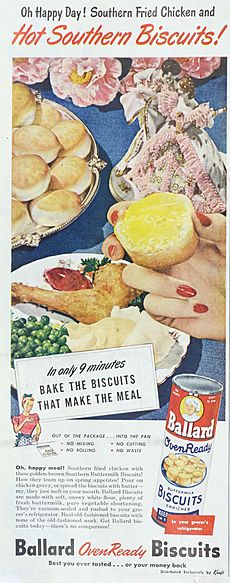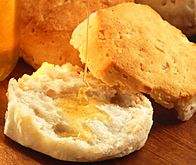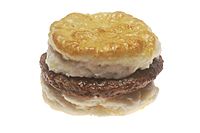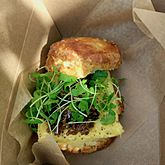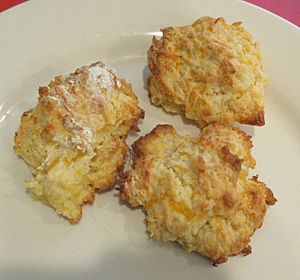Biscuit (bread) facts for kids
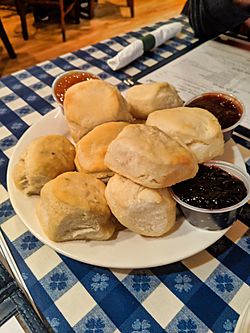
Biscuits with jelly
|
|
| Type | Bread |
|---|---|
| Place of origin | United States Canada |
| Main ingredients | Flour, baking powder or baking soda |
In the United States and Canada, a biscuit is a small, soft piece of bread. After baking, it usually has a slightly firm outside and a soft, crumbly inside. Biscuits are often made with baking powder or baking soda. These ingredients help the biscuit rise without needing yeast. Sometimes, they are called baking powder biscuits to show they are different from other types of biscuits.
Like other breads, biscuits are often served with butter or other toppings. You can also add other ingredients to them. They are great for making sandwiches or other dishes. Biscuits are a type of "quick bread." This means their dough does not need time to rise before baking.
Biscuits came from a very old food called hardtack. Hardtack was first made with just flour and water. Later, people added lard and then baking powder. Because biscuits have changed so much over time and in different places, the word "biscuit" can mean different baked goods depending on where you are.
Contents
The Story of Biscuits
How Biscuits Began
The words "biscuit" in American English and British English mean two different foods today. The first hard biscuits (which Americans call cookies) were a simple, long-lasting type of bread. The word "biscuit" comes from the old medieval Latin word biscoctus. This means "twice-cooked."
Today, the Italian baked goods called biscotti are very similar to these old "twice-cooked" items.
The reason for the different uses of "biscuit" in English is interesting. The author Elizabeth David explained it well. She said that soft biscuits were common in places like Scotland and Guernsey. The word "biscuit" for a soft bread stayed in these places and in America. But in England, it stopped being used for soft breads.
Early European settlers in the United States brought simple cooking styles with them. These often used ground wheat and were served with gravy. Many settlers were not rich, so biscuits were a cheap and filling food. The Royal Navy also used hard, flour-based biscuits. They kept well on long sea journeys. These hard biscuits were added to ship rations in 1588. They arrived in the New World by the 1700s.
The biscuit we know today became a distinct food in the early 1800s. This was before the American Civil War. Cooks wanted a cheap food that did not need expensive yeast. At first, they used pearlash to help biscuits rise, but it tasted bitter. So, people made "beaten biscuits." They would beat and fold the dough a lot to get air into it. This air made the biscuit rise when baked. Biscuits were also harder than bread slices. This meant they kept their shape better when used to soak up gravy.
In 1875, Alexander P. Ashbourne invented the first biscuit cutter in the US. It was used for cookies, cakes, and baking powder biscuits. His invention had a board to roll dough on. It also had a metal plate with different cutter shapes attached.
Modern Biscuits
Chefs in the Southern United States may have had an advantage in making biscuits. This is because of the type of flour grown there. Northern American flours come from hard wheat. This wheat grows in cold winter climates. Southern American flours come from soft winter wheat. This wheat grows in warm Southern summers. Soft wheat has less protein. This makes it better for quick breads like biscuits, as well as cookies, cakes, and muffins.
Today, you can buy ready-to-bake biscuits in stores. They come in small, refrigerated cardboard cans. These "refrigerator biscuits" were first patented by Ballard and Ballard in 1931.
How to Make Biscuits
A common biscuit recipe includes baking powder or baking soda, flour, salt, shortening or butter, and milk or buttermilk. The amounts of these ingredients can change. This is because recipes were often passed down through families. Biscuits are almost always a savory food. Sugar is rarely used, or only a very small amount is added.
Biscuits can be shaped in a few ways. The dough can be rolled flat and cut into rounds. These rounds expand when baked into flaky, layered shapes. If you add more liquid, the dough becomes like thick pancake batter. Then, small spoonfuls can be dropped onto a baking sheet. These are called drop biscuits. They have a more uneven shape and texture.
Most biscuits do not use yeast. However, a type called an angel biscuit does contain yeast. Some biscuits are also made with a sourdough starter.
Serving Biscuits
Biscuits are often eaten for breakfast. They are best served warm with butter, honey, or fruit jam. They can also be cut in half to make a Southern-style breakfast sandwich. You can fill them with Country ham, tomato, scrambled eggs, bacon, or sausage.
For dinner, biscuits are a popular side dish with fried chicken. They also go well with many types of Southern barbecue and Lowcountry dishes. Biscuits are also often part of a Southern Thanksgiving dinner.
-
Biscuits and gravy is a popular dish.
-
A breakfast sandwich with eggs, bacon jam, and microgreens on a buttermilk biscuit.
Biscuit Varieties
Large drop biscuits are sometimes called cat head biscuits. This is because of their size and rough shape.
You can add other flavors to biscuits. For example, you can add grated cheddar or American cheese to the basic recipe. This makes cheese biscuits.
Many home cooks use mass-produced, highly processed refrigerator biscuits. These are a quick way to make biscuits instead of rolling or dropping the dough.
Biscuits can even be cooked over a campfire on a stick!
A sweet biscuit layered or topped with fruit (like strawberries) and whipped cream is a type of shortcake.
Images for kids



